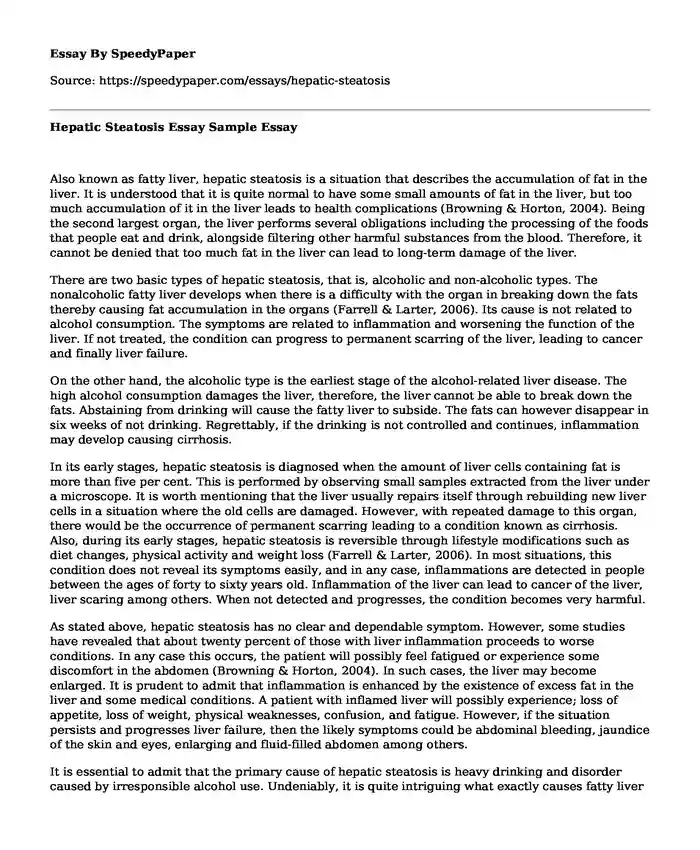Also known as fatty liver, hepatic steatosis is a situation that describes the accumulation of fat in the liver. It is understood that it is quite normal to have some small amounts of fat in the liver, but too much accumulation of it in the liver leads to health complications (Browning & Horton, 2004). Being the second largest organ, the liver performs several obligations including the processing of the foods that people eat and drink, alongside filtering other harmful substances from the blood. Therefore, it cannot be denied that too much fat in the liver can lead to long-term damage of the liver.
There are two basic types of hepatic steatosis, that is, alcoholic and non-alcoholic types. The nonalcoholic fatty liver develops when there is a difficulty with the organ in breaking down the fats thereby causing fat accumulation in the organs (Farrell & Larter, 2006). Its cause is not related to alcohol consumption. The symptoms are related to inflammation and worsening the function of the liver. If not treated, the condition can progress to permanent scarring of the liver, leading to cancer and finally liver failure.
On the other hand, the alcoholic type is the earliest stage of the alcohol-related liver disease. The high alcohol consumption damages the liver, therefore, the liver cannot be able to break down the fats. Abstaining from drinking will cause the fatty liver to subside. The fats can however disappear in six weeks of not drinking. Regrettably, if the drinking is not controlled and continues, inflammation may develop causing cirrhosis.
In its early stages, hepatic steatosis is diagnosed when the amount of liver cells containing fat is more than five per cent. This is performed by observing small samples extracted from the liver under a microscope. It is worth mentioning that the liver usually repairs itself through rebuilding new liver cells in a situation where the old cells are damaged. However, with repeated damage to this organ, there would be the occurrence of permanent scarring leading to a condition known as cirrhosis. Also, during its early stages, hepatic steatosis is reversible through lifestyle modifications such as diet changes, physical activity and weight loss (Farrell & Larter, 2006). In most situations, this condition does not reveal its symptoms easily, and in any case, inflammations are detected in people between the ages of forty to sixty years old. Inflammation of the liver can lead to cancer of the liver, liver scaring among others. When not detected and progresses, the condition becomes very harmful.
As stated above, hepatic steatosis has no clear and dependable symptom. However, some studies have revealed that about twenty percent of those with liver inflammation proceeds to worse conditions. In any case this occurs, the patient will possibly feel fatigued or experience some discomfort in the abdomen (Browning & Horton, 2004). In such cases, the liver may become enlarged. It is prudent to admit that inflammation is enhanced by the existence of excess fat in the liver and some medical conditions. A patient with inflamed liver will possibly experience; loss of appetite, loss of weight, physical weaknesses, confusion, and fatigue. However, if the situation persists and progresses liver failure, then the likely symptoms could be abdominal bleeding, jaundice of the skin and eyes, enlarging and fluid-filled abdomen among others.
It is essential to admit that the primary cause of hepatic steatosis is heavy drinking and disorder caused by irresponsible alcohol use. Undeniably, it is quite intriguing what exactly causes fatty liver in patients who do not drink alcohol even though it is understood that a high sugar content diet, higher body weight, diabetes, lack of physical activity as well as genetics can also play some role. The condition, that is, fatty liver, develops in a situation where the body creates a lot of fat or if the body is unable to metabolize fat efficiently (Browning & Horton, 2004). As a result, the excess fat stored due to lack of efficient metabolism is stored in the liver cells where it consequently accumulates and causes hepatic steatosis. Besides the alcohol use disorder, other causes of this condition are diabetes, genetic inheritance, rapid loss of weight, side effects of certain medications among others.
References
Browning, J. D., & Horton, J. D. (2004). Molecular mediators of hepatic steatosis and liver injury. The Journal of clinical investigation, 114(2), 147-152.
Farrell, G. C., & Larter, C. Z. (2006). Nonalcoholic fatty liver disease: from steatosis to cirrhosis. Hepatology, 43(S1), S99-S112.
Cite this page
Hepatic Steatosis Essay Sample. (2022, Sep 08). Retrieved from https://speedypaper.net/essays/hepatic-steatosis
Request Removal
If you are the original author of this essay and no longer wish to have it published on the SpeedyPaper website, please click below to request its removal:
- Free Essay Containing International Economy Research
- Free Essay: Participatory Evaluation in the Context of Educational Technology
- Essay Example: Tackling Poverty Is a Social Responsibility
- Essay Example: National Security Outweighs Citizen Privacy
- Free Essay on Analysis of Marx, Alienation and the Denial of Dignity of Work
- Business Ethics Essay Sample: Nissan Cars Case, Insider Trading and Other Ethical Dilemmas
- Essay Sample on Bill of Rights: Right to Privacy
Popular categories





